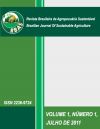INFLUENCE OF A SILVOPASTORAL SYSTEM ON FORAGE PARAMETERS IN THE BRAZILIAN SAVANNA
DOI:
https://doi.org/10.21206/rbas.v1i1.28Abstract
The association between pasture and tree is known as silvopastoral systems (SPS). Aimed at evaluating the forage produced in these systems, an experiment was conducted in Lagoa Santa, Minas Gerais, Brazil, 19° 35’ 36’’ S, 43° 51’ 56’’ W; altitude 747m. The system has been under development since 1984, through the natural regeneration of pioneer trees, of the Zeyheria tuberculosa Vell. Bur. species which are native to the Brazilian savanna. Brachiaria brizantha cv. Marandu (BBM) was the chosen forage and was collected in Jan 2006, a typical month of hydric stress. The production was assessed in terms of quantity and quality. In the density studied, 160 trees ha-1, the presence of trees in pastures of BBM caused no reduction in dry matter production (DMP) from forage. Tree components reduced the weather stress and enhanced the nutritional aspects of forage, increasing the crude protein (CP), phosphorus (P), and potassium (K) levels. Trees did not influence the calcium (Ca2+), neutral detergent fiber (NDF), acid detergent fiber (ADF), and lignin levels. Therefore, the SPS showed the potential to extend the forage quality availabilityDownloads
Download data is not yet available.
Downloads
Published
2011-07-01
How to Cite
Guilherme Lanna Reis, Ângela Maria Quintão Lana, Rogério Martins Maurício, Iran Borges, Gustavo Henrique Ferreira Abreu Moreira, Regina Maria Quintão Lana, Luciano Fernandes de Sousa, & Talmir Quinzeiro Neto. (2011). INFLUENCE OF A SILVOPASTORAL SYSTEM ON FORAGE PARAMETERS IN THE BRAZILIAN SAVANNA. Brazilian Journal of Sustainable Agriculture, 1(1). https://doi.org/10.21206/rbas.v1i1.28
Issue
Section
Artigos
License
1. Proposta de Política para Periódicos de Acesso Livre
Autores que publicam nesta revista concordam com os seguintes termos:
Autores mantém os direitos autorais e concedem à revista o direito de primeira publicação, com o trabalho simultaneamente licenciado sob a Licença Creative Commons Attribution que permite o compartilhamento do trabalho com reconhecimento da autoria e publicação inicial nesta revista.











